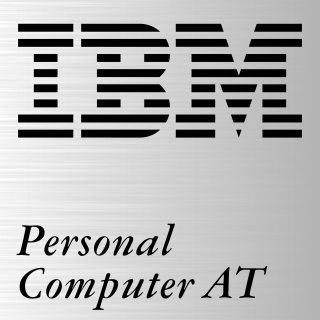
The technology of computer keyboards includes many elements. Many different keyboard technologies have been developed for consumer demands and optimized for industrial applications. The standard full-size (100%) computer alphanumeric keyboard typically uses 101 to 105 keys; keyboards integrated in laptop computers are typically less comprehensive.

A teleprinter is an electromechanical device that can be used to send and receive typed messages through various communications channels, in both point-to-point and point-to-multipoint configurations.

The ANITA Mark VII and ANITA Mark VIII calculators were launched simultaneously in late 1961 as the world's first all-electronic desktop calculators. Designed and built by the Bell Punch Co. in Britain, and marketed through its Sumlock Comptometer division, they used vacuum tubes and cold-cathode switching tubes in their logic circuits and nixie tubes for their numerical displays.

The IBM Personal Computer AT was released in 1984 as the fourth model in the IBM Personal Computer line, following the IBM PC/XT and its IBM Portable PC variant. It was designed around the Intel 80286 microprocessor.

The Comptometer was the first commercially successful key-driven mechanical calculator, patented in the United States by Dorr Felt in 1887.

In skydiving, an automatic activation device (AAD) is a dead man's switch consisting of an electronic-pyrotechnic or mechanical device that automatically activates the opening sequence of the main or reserve parachute container when the AAD is falling below a preset altitude and above a preset decent speed.

Cherry AG is a German computer peripheral-device maker. The company has its roots in the United States and is headquartered in Germany. It has additional offices in the United States, France, and China. They manufactured a large range of products including sensors, vibrators and automotive modules until 2008, when Peter Cherry, the son of Walter L. Cherry, sold his company to ZF Friedrichshafen AG, a German supplier to the automotive industry. Cherry was renamed ZF Electronics GmbH, while the Cherry brand was continued only for its computer input devices. Since the beginning of 2016 this product line has been operating independently on the market as the Cherry Group.

MinebeaMitsumi, Inc. is a Japanese multinational manufacturer of mechanical components and electronic devices. The company's headquarters are located in Higashi-Shinbashi, Minato, Tokyo, and its registered office is located in Miyota, Nagano.

A computer keyboard is a peripheral input device modeled after the typewriter keyboard which uses an arrangement of buttons or keys to act as mechanical levers or electronic switches. Replacing early punched cards and paper tape technology, interaction via teleprinter-style keyboards have been the main input method for computers since the 1970s, supplemented by the computer mouse since the 1980s.

ServerWorks Corporation was an American fabless semiconductor company based in Santa Clara, California, that manufactured chipsets for server computers and workstations running IA-32 microprocessors. Founded as Reliance Computer Corporation in 1994, it filed its initial public offering in the beginning of 2000 and was acquired by Broadcom for nearly US$1 billion.

A pullstring, pullcord, or pullchain is a string, cord, or chain wound on a spring-loaded spindle that engages a mechanism when it is pulled. It is most commonly used in toys and motorized equipment. More generally and commonly, a pullstring can be any type of string, cord, rope, or chain, attached to an object in some way used to pull or mechanically manipulate part of it.
TRW Vidar was an American telecommunications company, owned by TRW Inc., that made digital telephone switches from the mid-1970s to the early 1980s. They were the first, or one of the first, companies to make such a switch. Before being acquired by TRW Inc., they were known as Vidar Corporation and later, after a buyout, they were known as American Digital Switching.

Topre Corporation is a Japanese engineering company that manufactures stamped parts for automobiles, refrigeration units for trucks, air conditioners, and various other electronic and electro-mechanical equipment. It was founded in 1935 as Tokyo Press Kogyo Co. Ltd., in Kōtō, Tokyo.

The Keyboard Company, Inc., was an American electronics company based in Garden Grove, California. It was contracted by Apple Computer to produce the keyboards of their microcomputers in the late 1970s and early 1980s. The company also produced a number of peripherals separately for Apple's systems. Apple acquired the company in 1982 and renamed it the Apple Accessory Products Division (APD).

The RoadRunner was an early laptop designed by MicroOffice Systems Technology and introduced in 1983. Weighing roughly 5 pounds (2.3 kg) and featuring a battery able to power it for up to eight hours, the RoadRunner was one of the first clamshell notebook computers ever released.
The Micro Channel Developers Association (MCDA) was a consortium of computer manufacturers that sought to consider and prioritize steps in the maturation of the Micro Channel architecture, as well as to explore better approaches to disseminating technical information about Micro Channel to third parties.
Visual Technology, Inc., was an American computer company active from 1978 to 1993 and based in Middlesex County, Massachusetts. It produced a wide variety of smart terminals compatible with a wide variety of terminal protocols—mostly those of Digital Equipment Corporation (DEC)—as well as selling terminals with their own bespoke standards. Toward the end of its existence, it focused on the production of X terminals. In 1993, Visual Technology was acquired by White Pine Software.
Areal Technology, Inc., was an American hard disk drive manufacturer active from 1987 to 1999. The company was the first to produce hard drives employing glass as the substrate for their platters, allowing for significantly higher data densities and greater shock resistance. Other hard drives manufacturers across the board soon followed suit with this approach. In 1993, Areal was sold to Tomen Electronics and Sanyo, who operated the company as a joint venture. Areal continued as a subsidiary until 1999.
















